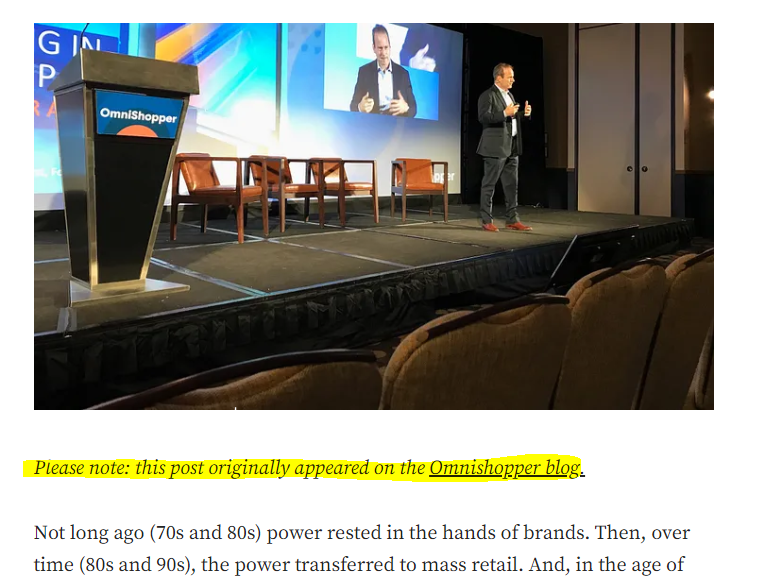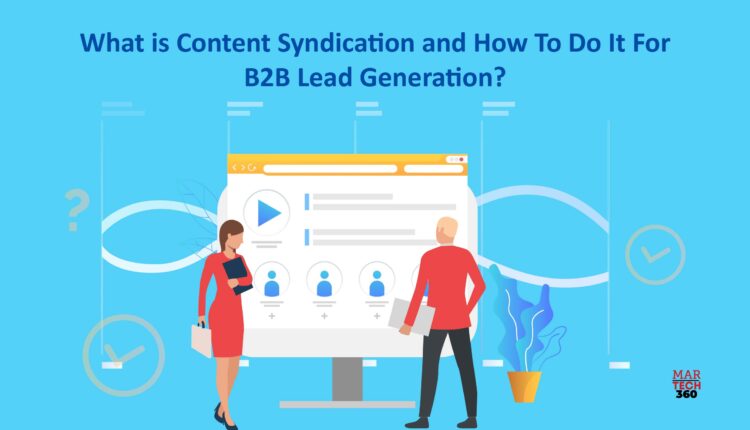Content syndication is a powerful market strategy that can help B2B lead generation. Instead of just posting it on websites, this marketing tactic gets your work in front of a wider audience.
Your target audience learns about you through a blog, ebook, podcast, etc. before even landing on your website. 65% of B2B marketers scale content marketing using this method, ultimately increasing their reach.
But that doesn’t mean it’s about quality over quantity. The real win is generating highly qualified leads. Content syndication helps businesses reach the right audiences, leading to higher conversions. This article delves into every aspect of it.
What is Content Syndication?
Content syndication is a marketing strategy that involves sharing your web content on other sites. The main goal is to reach a larger audience. This raises brand awareness, brings traffic, and may generate new leads or sales.
Sometimes, third-party websites republish the full content. Other times, they share an excerpt or condensed version.
 Syndicated content basically means republishing content across platforms. Similar to newspapers reprinting articles, syndication expands reach. The internet has made syndication more common. Many businesses utilize this strategy to grow their online presence.
Syndicated content basically means republishing content across platforms. Similar to newspapers reprinting articles, syndication expands reach. The internet has made syndication more common. Many businesses utilize this strategy to grow their online presence.
Syndication does not duplicate content or provide shortcuts. It’s a strategic move requiring careful planning and SEO best practices.
What Are the Benefits of Content Syndication?
 Sharing content allows you to get information from new people. So you can maximize your investment in content creation.
Sharing content allows you to get information from new people. So you can maximize your investment in content creation.
Collaborate with appropriate content partners, online distributors, or opinion leaders to heighten your brand’s visibility for your listers. Show that your brand is reliable and commanding in its sphere.
Also, the publisher might add a link to your website. This could boost visits from referrals and support SEO. Because Google sees some external links (backlinks) as signs of “trust.”
One potential syndication issue is that Google may not show it in searches. At least not how you’d want.
Google avoids duplicate results. So it shows the version described as “most user-appropriate for each search.” That may not be your preferred search engine page version.
This could cause problems sometimes (though less likely if you follow basic best practices).However, Google may view syndicated content as a duplicate. So it’s wise to use content syndication alongside original content marking efforts. That way, you don’t solely rely on syndicated content, which Google may penalize.
Content Syndication Benefits
- Scalable ROI: Content distribution boosts the value of your content by pulling leads into your pipeline. You can plan it and match your growth goals as a business. It also saves resources. Crafting quality content is time-consuming and expensive. By reusing your best content, you maximize returns while still giving your audience valuable information.
- Brand engagement boosts: With your content published across sites, you increase the odds of new audiences discovering it. This can drive more traffic to your site and potential conversions. This wider reach helps scale brand awareness and engagement. It’s a win for marking and demand generation techniques.
- Targeted audiences: Content syndication platform targets your specific buyer audience, eliminating unqualified leads from entering your sales funnel.
- Search engine optimization: When reputable sites syndicate your content, they often link back to your site. These backlinks can boost your SEO rankings, making it easier for potential customers to find you. Also, content syndication can position you as an industry thought leader. By having your content distributed across platforms, you increase your credibility and authority.
Content Syndication Vs Content Amplification
Content marketing uses two key approaches: syndication and amplification. Syndication repurposes existing content on other sites. It leverages those sites’ authority. It helps reach more people, generate leads, and boost SEO.
Content amplification promotes content through various channels to maximize reach and engagement. These channels include social media, email marketing, paid ads, and influencer marketing. Syndication republishes on third-party sites. Amplification pushes content across various channels. When used together, these strategies offer comprehensive content marking.
Which Types of Content are Most Effective For Syndication in B2B Lead Generation?
 Whitepapers and eBooks: These are thorough resources exploring industry subjects profoundly and delivering invaluable information, research findings, and solutions. They are remarkably effective for establishing thought leadership, showcasing expertise, and attracting leaders seeking in-depth knowledge.
Whitepapers and eBooks: These are thorough resources exploring industry subjects profoundly and delivering invaluable information, research findings, and solutions. They are remarkably effective for establishing thought leadership, showcasing expertise, and attracting leaders seeking in-depth knowledge.- Case studies: It showcases real examples where your product or service successfully addressed a client’s issue. Offering tangible evidence of the value you provide, they build trust with potential leads searching for similar solutions as described in the case study, acting as social proof.
- Webinars and Podcasts: These are interactive formats that let you directly engage your audience. They allow sharing experiences, discussing trends, providing educational content, and answering questions live. These formats enhance creativity, nurture relationships, and capture learners actively seeking knowledge and insights.
- Infographics: This presents intricate data in visually compelling, easily digestible formats. By condensing statistics or concepts into eye-catching graphics, they enable busy professionals to grasp key points rapidly. Highly shareable, infographics attract attention, generating leads when syndicated across platforms.
- Industry Reports and Research Papers: These offer exhaustive analysis, market trends, and data-driven insights relevant to your target audience. Sharing original research or analysis positions you as a trusted authority in your industry. This content attracts leads actively seeking reliable, up-to-date information.
- Blog Posts: Blogs give information on problems. They offer fixes and tips. They help your brand be a thought leader. Blog posts are spread on sites, drawing attention to them. This attracts leads seeking information in your field.
- Videos: Videos engage viewers. You can show product features, share success tales, teach how-tos, or discuss trends. Videos let you share information in an exciting, visual way. This catches the viewer’s attention. Videos can go on YouTube, social media, or in blog posts. This brings in learners who like video content.
Also Read: 5 Content Syndication Best Practices: A Detailed Guide
How Content Syndication Solves B2B Lead Generation Challenges?
Low brand visibility severely impacts lead generation, recognition, and marking performance. When B2B firms lack visibility, their target market is unaware that it exists. This results in missed opportunities, decreased awareness, and reduced sales. If potential customers don’t know your products or services, you can’t attract interest or traffic. No inbound leads make it harder for sales teams to meet goals.
Visibility challenges affect all B2B marketing campaigns. If efforts don’t reach the right audience or enough people, campaigns have a low ROI. You’re wasting resources that could distribute content to likely converters. Social ads alone don’t ensure long-term B2B visibility.
Content syndication overcomes this obstacle. By syndicating content, you distribute valuable materials to a wider, relevant audience.
How Does Content Syndication Relate To Seo?
Sharing content across multiple sites is called syndication. This presents difficulties for search engines because Google doesn’t like duplicate versions of the same text online. It will rank only one version highly. Typically, that means a large, popular website is preferred over lesser-known creators.
So syndication may help expose your content, but it may also reduce traffic to your own site. This happens because search engines ignore duplicates when ranking pages. Your syndicated article is considered a copy, so the major site hosting it ranks higher.
Don’t worry—you can optimize syndicated content for search. Take steps to ensure Google recognizes your site as the original source. Work with syndication partners to properly attribute and link back to you.
5 Content Syndication Best Practices
- Adapt the content suitably: Enhance it with links or calls-to-action guiding external readers to your website. Or tailor it for the new audience and format comprehensibility.
- Utilize canonical tags wisely: Google recommends signaling the version preferred in search results through canonical tags for syndicated content.
- Incorporate a backlink to your site: Google’s guidance advocates each syndicated article containing a trackback to the original piece, benefiting SEO while driving valuable traffic.
- Promote syndicated content: Sharing links to third-party published content across social platforms effectively attracts readers.
- Analyze key performance indicators: Monitor metrics like referral traffic to identify effective strategies and refine your content syndication marketing approach accordingly.
How Do You Choose the Ideal Content Syndication Solution?
Picking the right content syndication solution is key to your business strategy. Consider the following points:
- Service’s network size: Verify that their spread across websites and blogs aligns with your intentions. Does it reach those who are most relevant?
- Cost: Compare rates carefully across options. Will potential gains justify the investment?
- Analytics offered: The service must provide in-depth reporting to gauge your syndication performance accurately.
- Client support quality: top-notch customer service should be a priority in case you need assistance.
End Note
Content syndication is a strong way to market. It helps drive people, make leads, and increase changes. Whether you pick free or paid syndication solutions, it’s important to create high-quality content and choose the right partners. With the right strategy, content sharing can help reach new people, set your brand as a thought leader, and ultimately grow the business.


Comments are closed.